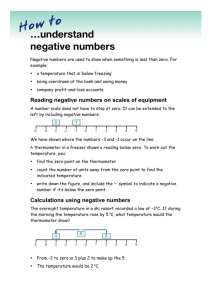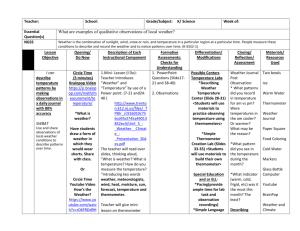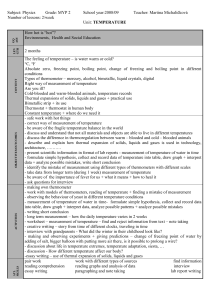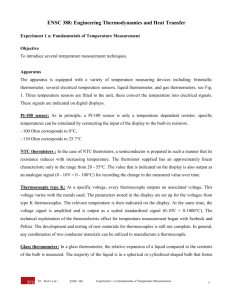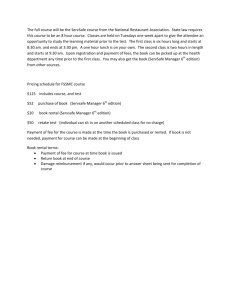Chapter 4 – The Flow of Food: An Introduction
advertisement
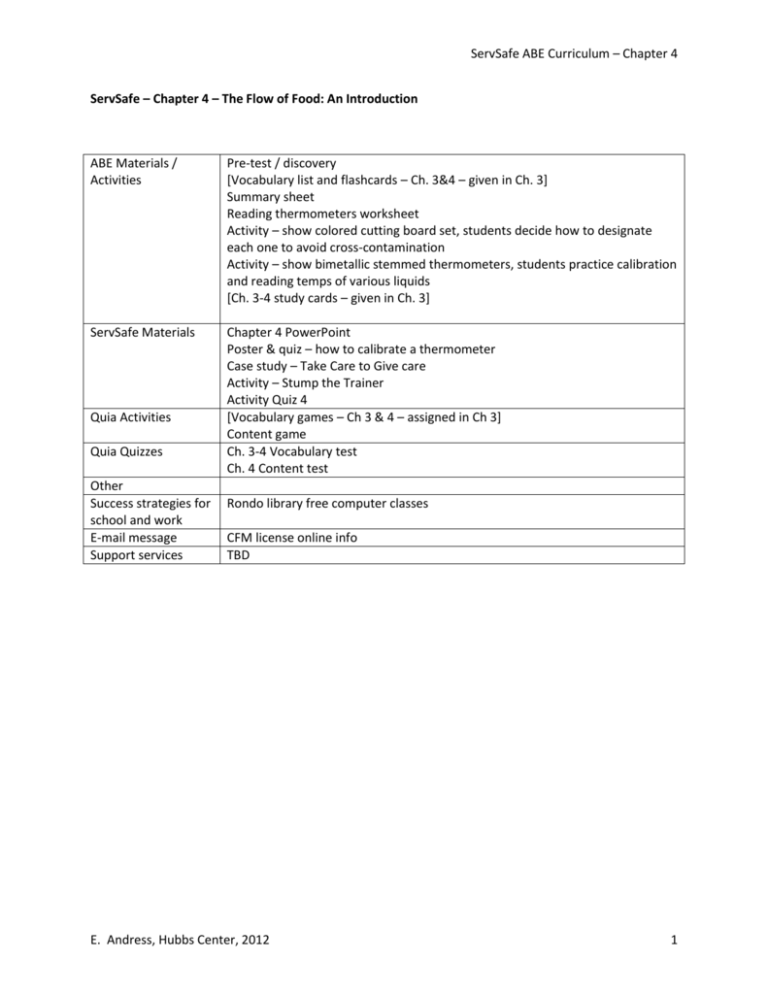
ServSafe ABE Curriculum – Chapter 4 ServSafe – Chapter 4 – The Flow of Food: An Introduction ABE Materials / Activities Pre-test / discovery [Vocabulary list and flashcards – Ch. 3&4 – given in Ch. 3] Summary sheet Reading thermometers worksheet Activity – show colored cutting board set, students decide how to designate each one to avoid cross-contamination Activity – show bimetallic stemmed thermometers, students practice calibration and reading temps of various liquids [Ch. 3-4 study cards – given in Ch. 3] ServSafe Materials Chapter 4 PowerPoint Poster & quiz – how to calibrate a thermometer Case study – Take Care to Give care Activity – Stump the Trainer Activity Quiz 4 [Vocabulary games – Ch 3 & 4 – assigned in Ch 3] Content game Ch. 3-4 Vocabulary test Ch. 4 Content test Quia Activities Quia Quizzes Other Success strategies for school and work E-mail message Support services Rondo library free computer classes CFM license online info TBD E. Andress, Hubbs Center, 2012 1 ServSafe ABE Curriculum – Chapter 4 Chapter 4 – The Flow of Food: An Introduction – Pre-test Write T (true), F (false) or ? (I don’t know) next to each statement. Then check your answers by looking in your book at the page number provided. _______ 1. Chicken held at an internal temperature of 125°F (52°C) has been temperature abused. (p. 4.4) _______ 2. Infrared thermometers are best for measuring the internal temperature of food. (p. 4.8) _______ 3. When checking the temperature of a roast using a bimetallic stemmed thermometer, only the tip of the thermometer stem should be inserted into the product. (p. 4.6) _______ 4. Calibration of a thermometer is necessary to make sure the thermometer does not contaminate food. (p. 4.9) _______ 5. Washing and rinsing a cutting board will prevent it from crosscontaminating the next product placed on it. (p. 4.3) Chapter 4 – The Flow of Food: An Introduction – Pre-test Write T (true), F (false) or ? (I don’t know) next to each statement. Then check your answers by looking in your book at the page number provided. _______ 1. Chicken held at an internal temperature of 125°F (52°C) has been temperature abused. (p. 4.4) _______ 2. Infrared thermometers are best for measuring the internal temperature of food. (p. 4.8) _______ 3. When checking the temperature of a roast using a bimetallic stemmed thermometer, only the tip of the thermometer stem should be inserted into the product. (p. 4.6) _______ 4. Calibration of a thermometer is necessary to make sure the thermometer does not contaminate food. (p. 4.9) _______ 5. Washing and rinsing a cutting board will prevent it from crosscontaminating the next product placed on it. (p. 4.3) E. Andress, Hubbs Center, 2012 2 ServSafe ABE Curriculum – Chapter 4 Pre-test – KEY 1. 2. 3. 4. 5. T F– F– F– F– internal temperature of food surface temperature of equipment only the tip… the thermometer must be inserted up to the dimple does not contaminate food gives an accurate reading washing and rinsing washing, rinsing and sanitizing E. Andress, Hubbs Center, 2012 3 ServSafe ABE Curriculum – Chapter 4 Chapter 4 – The Flow of Food: An Introduction How do I do that? (p. 4.3) How can I prevent crosscontamination? Keep raw and ready-to-eat food separate. 1. 2. 3. 4. How can food be time-temperature abused? How can I avoid time-temperature abuse? When food is handled in these ways: (p. 4.4) Five procedures are important: (p. 4.4) 1. 1. 2. 2. 3. 3. 4. 5. (p. 4.4) Temperature danger zone: ________________ “Red zone” – pathogens grow esp. fast: ____________ E. Andress, Hubbs Center, 2012 4 ServSafe ABE Curriculum – Chapter 4 What kinds of thermometers are used for food safety? (p. 4.6-4.8) Bimetallic stemmed thermometer Thermocouple / thermistor Other temperature-recording devices Infrared (laser) thermometer Maximum registering thermometer Time-temperature indicator (TTI) General Thermometer Guidelines (p. 4.9) E. Andress, Hubbs Center, 2012 5 ServSafe ABE Curriculum – Chapter 4 Reading Thermometers A. Scale: When reading a thermometer, you must first understand the scale. Scale means the number of degrees for each line. Look at the thermometers below. How many degrees for each line? ____ Look at the thermometer you have in the classroom. What is the scale? ____ B. Read the thermometers below. Write the temperature above each. 1. _______ 2. _______ 3. _______ 4. _______ E. Andress, Hubbs Center, 2012 6 ServSafe ABE Curriculum – Chapter 4 C. Draw the temperature on the thermometer. 1. 40°F 2. 3. 142°F 4. 96°F 5. 135°F 6. 32°F E. Andress, Hubbs Center, 2012 90°F 7


